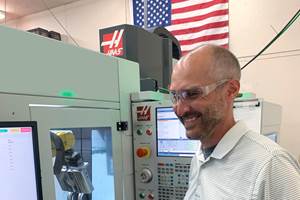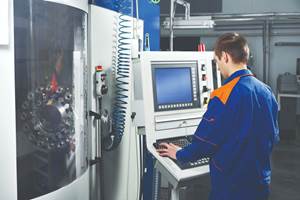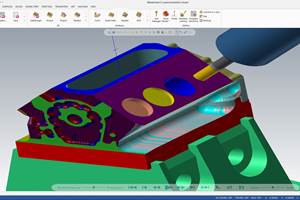The Right CAM Program Helps Machine Maker Meet Mandate
Mueller Tool and Machine's main focus is designing and building machinery that forms and finishes copper-tubing fittings for the plumbing and heating marketplace. Not available commercially, its custom machinery includes machines for facing copper fittings, and hydraulic presses with closed-loop programmable ram-control--which automate the push-forming of copper elbows.
Mueller Tool & Machine, Inc. (Covington, Tennessee), a subsidiary of Mueller Industries, opened with the mandate to design and make special machines and tooling that would enable its parent company's production lines to produce copper-tubing fittings more productively.
"The special machinery that we build for our parent company's assembly lines has increased production and throughput at three of our facilities, but we still have 17 other locations waiting for us to design and supply similar tooling," says Jim Boshart, process and equipment engineer.
Mueller Tool and Machine's main focus is designing and building machinery that forms and finishes copper-tubing fittings for the plumbing and heating marketplace. Not available commercially, its custom machinery includes machines for facing copper fittings, and hydraulic presses with closed-loop programmable ram-control (which automate the push-forming of copper elbows).
The five-man design-engineering team uses CADKEY solid modeling software (CADKEY Corp. - formerly known as Baystate Technologies) on high-end PCs to design its machinery and tooling. Mr. Boshart put that CAD program in place because he had used it successfully at another location before joining Mueller to set up the Covington plant.
"We opened the plant with the ability to do CAD design with a 2D program having 3D wireframe capabilities," says Mr. Boshart. "Within just a few months, we saw that we needed the ability to do solid modeling to really achieve corporate expectations. So, in early '97 we switched to a new CADKEY 3D program, which saved us design time and errors by not requiring that we create separate views, from scratch, of each object we designed. Initially, we had to learn to think in 3D terms; but within six months, the new program had increased our design output dramatically, which allowed us to get more machinery and tooling out the door. At the time that it updated to 3D CAD, Mueller Tool & Machine also installed a leading CAM program to achieve the benefits of no longer having to write G-code programming to run in-shop CNC machinery. But soon the shop recognized that the program couldn't adequately handle solid-modeling ASIS input. For a solution, the shop turned to its CAD reseller, Mitch Free, of 3 Datum, and on his recommendation replaced its current CAM package with Virtual Gibbs Solid Surfacer, from Gibbs and Associates (Moorpark, California).
With Virtual Gibbs, the shop found that it took about one-fifth the time to generate CAM programming as before. A machined punch that required programming in four to five steps now could be completed in one step.
The shop was able to generate machining sequences that weren't possible with the previous program, and the new program was more stable. Programs that were previously generated and saved would now re-run flawlessly every time—without having to generate new geometry for repeat runs, as before.
"Virtual Gibbs really got our machines up and running and producing parts," Mr. Boshart emphasizes. "CAM download time was cut in half, which cut setup time in half for each CNC machine. This enabled a machine to begin cutting—and a second machine to be programmed and started—within the time frame formerly required to set up just one machine. One result was a doubling in our work capacity without adding additional machinery. Today, when you go into the shop, all of our machines are running and producing. That increase in uptime translates to dramatically increased production of parts.
The synergy of the CAD/CAM programming has been the key factor in meeting the operational mandate for Mueller's parent company, says Mr. Boshart.
Related Content
5 Reasons Why Machine Shop Ownership Is Changing
Mergers, acquisitions and other ownership changes are an effect of Boomer-age shop owners retiring, but only in part. Also important: The way we think about machining has changed.
Read MoreUnderstanding CNC Machine Accuracy and Repeatability
Properly evaluating machine tool capability requires understanding how the both user and the builder can influence precision.
Read MoreCAD/CAM System Requirements: An Overview
CAD/CAM programs are among the most demanding kinds of computer software. Smooth operation requires careful consideration of computer specifications.
Read More7 CNC Parameters You Should Know
Parameters tell the CNC every little detail about the specific machine tool being used, and how all CNC features and functions are to be utilized.
Read MoreRead Next
3 Mistakes That Cause CNC Programs to Fail
Despite enhancements to manufacturing technology, there are still issues today that can cause programs to fail. These failures can cause lost time, scrapped parts, damaged machines and even injured operators.
Read MoreThe Cut Scene: The Finer Details of Large-Format Machining
Small details and features can have an outsized impact on large parts, such as Barbco’s collapsible utility drill head.
Read More

























